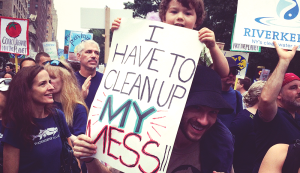 In anticipation of a meeting of world leaders at the United Nations Climate Summit on Tuesday, over 400,000 people — double the expected attendance — participated in the People’s Climate March in New York City on Sunday, including over 40 Georgetown students.
In anticipation of a meeting of world leaders at the United Nations Climate Summit on Tuesday, over 400,000 people — double the expected attendance — participated in the People’s Climate March in New York City on Sunday, including over 40 Georgetown students.
The march, organized by 350.org, began around 11:30 a.m. and wound its way throughout downtown Manhattan, traversing 40 blocks. At 12:58 p.m., the attendees held a moment of silence that lasted until 1 p.m. for frontline communities already affected by climate change. They continued the march through Times Square before concluding the event at Penn Station.
An estimated 2,000 similar events were held in 150 countries, including larger demonstrations in London and Paris.
Georgetown students, including members of Georgetown University Fossil Free, organized to attend the march in conjunction with the Sierra Club, American University and The George Washington University. While approximately 70 students bought $20 tickets for chartered buses to and from the event, attendee Caroline James (COL ’16), a member of GU Fossil Free and the Georgetown University Student Association secretary of sustainability, estimated that 40 students actually made the trip to New York.
“We got a lot of people to come, more than we’ve ever gotten people to come for an external climate event,” James said. “There are some people that I know are supportive of the environmental cause but just aren’t involved on campus because they’re involved in other stuff, so I was really happy to see them because it takes major initiative and a bit of sacrifice to get yourself up to New York.”
The march preceded the U.N. Climate Summit led by Secretary-General Ban Ki-Moon that will be held today in New York, which will convene world leaders, including President Barack Obama, to discuss the issue of climate change and possible policy situations. GUSA Undersecretary of Sustainability Mandy Lee (SFS ’17), also marched, believing that the proximity to the event could spark real action.
“This has been the largest climate march in history, and it’s all in order to send a message that negotiations need to have a real impact in the future since climate conferences have been so ineffective so far,” Lee said. “Personally, I’d like to see commitments about climate change that have real deadlines.”
James also said she hoped the march would bring accountability to leaders at climate summits.
“Just having our bodies there demanding loudly that this is something that cannot wait any longer brings probably a sense of urgency to this issue for them, and they know that we’re watching,” she said.
In addition to political figures Ban and New York City mayor Bill de Blasio and celebrities like Leonardo DiCaprio and Joseph Gordon-Levitt, the march brought together a multitude of organizations, including student groups, religious organizations, scientists, teachers and others.
“There were so many groups there. I’m interested in divestment as a member of GU Fossil Free, but I’m also interested in the fracking industry, and there were people fighting coal and oil, people interested in food justice,” Chloe Lazarus (COL ’16) said. “It was such an array of messages since everything is related to climate change and climate justice.”
Ari Goldstein (COL ’18), another attendee, said that he hoped the march would spark the environmental movement in a manner similar to major activist pushes of the 20th century.
“GU Fossil Free hosted a movie screening last week that was a movie called ‘Disruption,’ and it talked about the need for mobilization of people in any social movement. It talked about the civil rights movement and the feminist movement, and it struck me that that’s what’s necessary for the environmental movement,” he said.
Attendees of the march, many of whom were members of GU Fossil Free, hoped that the attention placed on the march would pressure the administration to divest from fossil fuel companies, the central mission of the organization.
With the significant involvement of Georgetown students at the march, Lee also wanted to ensure that the university would remain a leader in the environmental movement.
“I hope to make Georgetown feel as though it’s a leader in, at least, thought in this area, if not in action,” she said. “I’d like to see students think about environmental issues on a daily basis when they’re making little daily decisions, just changing little behaviors.”




















